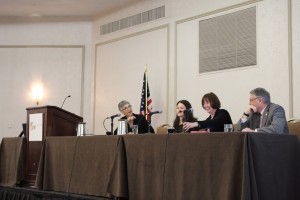In the past few weeks, a number of studies have been released focusing on jobs and careers. Below is a quick rundown of some of the most salient reports.
The U.S. Departments of Education, Labor and Transportation: Strengthening Skills Training and Career Pathways across the Transportation Industry
This joint report, building on the collaboration across these agencies to better align career pathways initiatives and efforts, details the potential employment opportunities throughout the transportation industry, broken down by subsectors, occupations, career areas and geography. A core finding is that transportation industry employers are expected to hire and train roughly 4.6 million workers, an equivalent of 1.2 times the current workforce, to meet the needs of growth, retirement and turnover in the next decade.
Jobs for the Future: Promising Practices in Young Adult Employment
Jobs for the Future has released a series of three briefs to support ways in which education, employers and workforce development can better collaborate to combat the chronic high unemployment of our youngest adults. They released case studies on an EMT Career Pathway program in New Jersey; automotive and manufacturing Career Pathways in Wisconsin and Virginia; and a multi-disciplinary career exploration program in Milwaukee, Wisconsin, each of which detail the specific actions taken by employers and workforce development leaders.
Center on Education and the Workforce: Good Jobs Are Back: College Graduates Are First in Line
The latest report from Georgetown’s Center for Education and the Workforce focuses on how many of the jobs created since the Great Recession are “good jobs,†which according to the Center:
- Pay more than $53,000 annually for a full-time, full-year worker (more than 26% above the median earnings of all full-time, full-year workers, which is $42,000), and
- Typically are full-time (86%), offer health insurance (68%), and provide an employer-sponsored retirement plan (61 percent).
 The report finds that 2.9 million of the 6.6 million jobs added over the Recovery are “good jobs,†most of which require at least a bachelor’s degree. Consistent with many of the Center’s other reports, “Good Jobs Are Back” finds that individuals with a high school diploma or less as the most likely to suffer during and beyond the Recession and Recovery.
The report finds that 2.9 million of the 6.6 million jobs added over the Recovery are “good jobs,†most of which require at least a bachelor’s degree. Consistent with many of the Center’s other reports, “Good Jobs Are Back” finds that individuals with a high school diploma or less as the most likely to suffer during and beyond the Recession and Recovery.
Young Invicibles: Best Jobs for Millennials
Focusing on careers that will provide millennials with the greatest opportunities, Young Invincibles analyzed Bureau of Labor Statistics data using three criteria: projected occupation growth by 2022, median wage and “Millennial share,†or the percentage of the total jobs in that occupation held by young adults aged 18-34. Based on the criteria and a ranking system, the report found that physician assistants, actuaries, statisticians, biomedical engineers and computer and information research scientists were the five best jobs out there for young adults. Across the list of the 25 best jobs identified, over half are “STEM†and nearly all require some education and training beyond high school, a number of which require less than a four-year degree.
Kate Blosveren, Associate Executive Director


 In a very spirited panel discussion, three leading experts in credentials shared some challenges and opportunities in building, validating and scaling industry-recognized credentials and certifications at NASDCTEc’s annual Spring Meeting last week.
In a very spirited panel discussion, three leading experts in credentials shared some challenges and opportunities in building, validating and scaling industry-recognized credentials and certifications at NASDCTEc’s annual Spring Meeting last week.